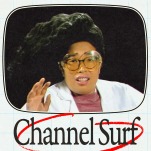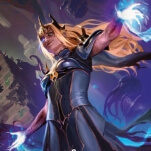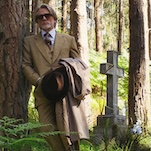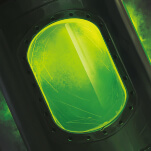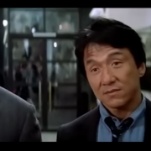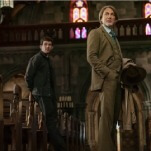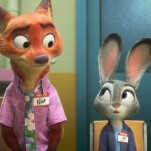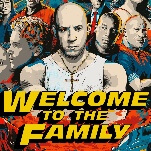Welcome to the Tournament Of Episodes, an unending game of bloodsport between some of the best episodes of the 2013-14 TV season, inspired by The Morning News’ Tournament Of Books. To learn more and see the schedule, go here.
It’s time for our readers’ choice round, in which your picks head into battle against ours. Today, your choice is Community’s “Cooperative Polygraphy,” which takes on Breaking Bad’s “Ozymandias.” The latter got here by beating True Detective, The Returned, and Girls. The former got here because you voted for it! Erik Adams has the call.
Breaking Bad, “Ozymandias” vs. Community, “Cooperative Polygraphy”
Erik Adams: So there’s this movie in which Meryl Streep plays a Polish immigrant…
Okay, maybe a Sophie’s Choice joke isn’t the most tasteful way to begin a discussion of these two episodes—especially when one of them contains a depiction of forced labor. But like Liz Lemon, I long ago developed a sense of sarcasm to mask my insecurities—and few decisions have made me feel more insecure than having to elevate one of these episodes over the other. Pick between the crowning culmination of Breaking Bad’s five seasons and a Community tour de force that forgoes the usual markings of a Community tour de force? This is like watching a psychopathic weapons expert devour all of your pet fish, saving your absolute favorite for last. (And the Fish Called Wanda reference pivots into another “Kevin Kline movie from the ’80s” allusion—are you happy now?)
Loath as I am to compare the merits of these two shining beacons of the 2013-14 television season, I love how they sync up and complement each other. Both “Ozymandias” and “Cooperative Polygraphy” concern the art of deception. Both wrap their stories around obscenely large amounts of money. The scripts give a totemic power to peculiar-looking containers. Parenthood is an overlapping theme. Characters locate things buried in the ground using GPS. Accusations are thrown around. There’s a lot of shouting. Bald, slightly overweight white men die. It’s even harder to declare a winner between “Cooperative Polygraphy” and “Ozymandias” because they’re pretty much the same episode.
The primary distinctions are those of scale. The Breaking Bad episode is fucking huge, but it’s also a miraculous act of TV compression: Prior to re-watching it, I primarily remembered “Ozymandias” as “The One With Walter White’s Big Lie,” the fiery phone call in which Walt (Bryan Cranston) implicates himself as the sole mastermind of the Heisenberg methamphetamine empire, throwing the police off the trail of his wife and family. What I didn’t remember is that it’s also “The One Where Hank Dies,” “The One With Walt’s Sisyphean Barrel Roll,” “The One Where Walt Jr. Finds Out,” and “The One With The White Family Knife Fight.” It’s a lot to cover in 45 minutes, but as written by Moira Walley-Beckett and directed by Rian Johnson, it moves through all of that plot with speed and grace that Walt probably wishes his big, plastic drum of cash possessed.
“Cooperative Polygraphy,” meanwhile, is a small-scale sleight-of-hand trick, a Community mini-epic in the style of “Cooperative Calligraphy” (its predecessor in title and spirit) and “Advanced Dungeons & Dragons.” Whenever I hear people criticize Community for being a bunch of geeky references and genre experimentation haphazardly hung on the framework of older, more distinct sitcoms, these are the episodes I point to. Empty characterization? “Cooperative Polygraphy” has nothing but character and relationships to draw upon, and it’s easily one of the funniest, most daring episodes of the series—a top 10 candidate, for sure. With the central study group hooked up to a polygraph machine in order to determine that they’re not the late Pierce Hawthorne’s murderer (how’s that for a hackneyed sitcom setup?), “Cooperative Polygraphy” uses the device to establish a thrilling sense of rhythm. I think this is going to be where my personal biases start seeping into the decision-making: I love this sort of “episode on wheels” type of TV-making, where the story presents an engine that either propels (like the combo death-row appeal/new-firm conspiracy from The Good Wife’s most recent season premiere) or pulls (like the “blood cookie” that hangs over Liz’s head in 30 Rock’s “Tracy Does Conan”) the action ever forward. “Ozymandias” moves swiftly, but “Cooperative Polygraphy” is swifter, marching forward to the drum beat of “Lie!”
Deception is a difficult game to play on TV; certain hats need to be tipped toward the audience in order for any lie to be satisfyingly conveyed. Breaking Bad begins with a lie, one revisited at the top of “Ozymandias”—what better way to have the viewer look upon Walt’s works, we mighty, and despair? “Cooperative Polygraphy” depends on the little lies people tell one another (and themselves) every day, even when they spend a good portion of those days seated around a table with the same four or five people. There’s catharsis in letting the lies go: Seemingly pitted against one another by a dead man, Community’s study group reclaims that manipulative power by divulging the truth on its own terms. (Britta’s “I only give money to homeless people when I’m walking with someone” escalates/devolves to Abed’s “When any of you chew gum, I want to punch you.”) Later, when Walton Goggins’ Mr. Stone is free to drop his stone-faced front, he’s practically exploding with energy.
And yet for all their confessions, both episodes keep their endgames expertly hidden. For Walt, his game of Skyler-clearing telephone is a matter of being backed into a corner; the Greendale Seven (who are now six) are genuinely held in the dark about Pierce’s true intentions until the final questions and liquid-nitrogen-cooled cylinders of the dead man’s genetic material are handed out. In that final sequence, the script swaps the metronome-like verbal interjections of the polygraph staff for the visual gag of the technician distributing bequeathments and sperm, one that retains its sense of surprise thanks to director Tristram Shapeero and his decision to play around with one of Community’s most familiar camera setups. The tech pops in and out of the show’s standard, at-the-study-table medium shots, working in concert with the editing to preserve the episode’s all-important pacing
It’s that sequence that lifted the onus off my decision. I love these episodes almost equally, but “Cooperative Polygraphy” makes me feel the full intensity of that love, an intensity heightened by the emotional roller coaster of Pierce revealing his true feelings for the six people seated at the study table. Breaking Bad is one of the best shows of the past decade (sorry, Walt—Don Draper’s always going to have one up on you in this critic’s eye), and “Ozymandias” is effective, cinematic proof of everything a great TV series can be. But what continues to wow me about “Cooperative Polygraphy” is how it demonstrates what great TV doesn’t have to be: You don’t have to stage a shout-y knife fight to pull at heartstrings. Tremendous drama with extremely high stakes can originate simply from well-maintained, carefully cultivated relationships. You don’t even have to show a character (or the contentious actor who played him) to make that character have an impact on the story. Not that it’s all stark minimalism: One mention of the fake name “Butts Carlton” is good, but two mentions in short succession (the second recited in the affirmative deadpan of a woman behind a polygraph screen) is even better. I’ve been tasked with making a subjective choice between two stellar episodes of television, and I cannot tell a lie: I choose the Community one.
Winner: Community, “Cooperative Polygraphy”
Disagree? Agree? Vote either way in our poll.
Tomorrow: The second readers’ choice round presents Todd VanDerWerff with a choice between
The Good Wife’s “Hitting The Fan” and
Mad Men’s “The Strategy.”

